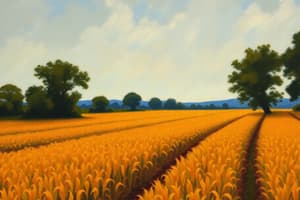Podcast
Questions and Answers
What are some common forestry operations?
What are some common forestry operations?
Logging, timber extraction, preparation of wood products like lumber, pulp, and paper
What are some examples of aquatic species involved in fisheries?
What are some examples of aquatic species involved in fisheries?
Fish, mollusks, crustaceans, seaweeds
How does agriculture contribute to economic growth in rural areas?
How does agriculture contribute to economic growth in rural areas?
By offering employment opportunities along the supply chain from farm to table
How do modern agricultural technologies increase productivity?
How do modern agricultural technologies increase productivity?
How do sustainable agricultural practices help protect the environment?
How do sustainable agricultural practices help protect the environment?
Why is agriculture considered the backbone of sustainable food systems?
Why is agriculture considered the backbone of sustainable food systems?
What are some key aspects of agriculture highlighted in the text?
What are some key aspects of agriculture highlighted in the text?
Describe the process of crop production as outlined in the text.
Describe the process of crop production as outlined in the text.
What are some examples of crops mentioned in the text?
What are some examples of crops mentioned in the text?
What is the purpose of livestock rearing?
What is the purpose of livestock rearing?
How do crop farmers promote growth in plants?
How do crop farmers promote growth in plants?
What happens to harvested crops before reaching consumers' tables?
What happens to harvested crops before reaching consumers' tables?
Study Notes
Agriculture: The Backbone of Sustainable Food Systems
Agriculture is a vital sector that supports sustainable food systems worldwide. It plays a crucial role in providing food security, promoting rural development, and protecting the environment. Farming practices encompass various techniques such as crop cultivation, livestock rearing, fisheries, and forestry, all aimed at producing nutritious food products for human consumption. In this article, we will explore key aspects of agriculture and its importance in fostering sustainable food systems.
Crop Production
Crop production involves growing plants such as fruits, vegetables, grains, and other cereals like wheat, rice, maize, and barley. This process begins with planting seeds or seedlings, followed by the necessary water, sunlight, and nutrients to allow them to grow into mature plants. Crop farmers may employ various methods to promote growth, including irrigation, fertilization, pest control, and disease management. The harvested crops are then transported to processing facilities, where they undergo further refinement before reaching consumers' tables.
Livestock Rearing
Livestock rearing involves raising animals such as cows, pigs, chickens, sheep, goats, horses, fish, and insects for meat, milk, eggs, and other animal products like wool and leather. These animals can graze on pastures, nibble on fodder crops, or be fed concentrates like feed grain from farmers and producers. Good animal husbandry practices ensure their health, wellbeing, and productive lifecycles while minimizing negative impacts on the planet.
Forestry and Fisheries
Forestry focuses on managing forests and trees for wood and non-wood products, biodiversity conservation, carbon sequestration, and generating income opportunities through various activities. Some common forestry operations include logging, timber extraction, and the preparation of wood products like lumber, pulp, and paper. On the other hand, fisheries involve catching and farming aquatic species like fish, mollusks, crustaceans, and seaweeds. Both sectors play integral roles in ensuring food security, particularly in regions where wild capture fishing and traditional forest livelihoods predominate.
Supporting Rural Development
Agriculture contributes significantly to economic growth and job creation in rural areas, offering employment opportunities along the entire supply chain from farm to table. Smallholder farmers often rely on agriculture for their livelihoods and generate additional income through value addition and trade. Moreover, modern agricultural technologies and innovations have increased productivity, making it possible to produce more food with fewer resources and reducing rural poverty.
Environmental Protection
Sustainable agricultural practices help protect the environment by conserving natural habitats, maintaining soil quality, supporting pollinators, and preserving ecosystem services. For instance, integrated crop management reduces the need for chemical inputs, whereas conservation tillage helps maintain soil productivity and reduce greenhouse gas emissions. Additionally, farmers can cultivate diverse crops, which promotes biodiversity and supports resilient food systems.
In conclusion, agriculture is the backbone of sustainable food systems worldwide. It provides food security, supports rural development, and protects the environment. By promoting sustainable farming practices, we can ensure a stable food supply while safeguarding the planet for future generations.
Studying That Suits You
Use AI to generate personalized quizzes and flashcards to suit your learning preferences.
Description
Explore the vital role of sustainable agriculture in fostering food security, rural development, and environmental protection. Learn about crop production, livestock rearing, forestry, and fisheries practices that support sustainable food systems worldwide.




